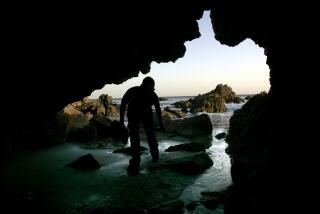Forest Service Fee Plan Assailed
OJAI — A local environmental group contends that the U.S. Forest Service’s pay-to-play program is falling short of expectations and siphoning money from much-needed forest improvements.
Members of the Ojai-based Keep the Sespe Wild said Monday they estimate that the Adventure Pass program, which requires forest visitors to pay $5 a day or $30 for the year, ran at a loss of nearly $1.2 million in 1997, the first year of the three-year pilot project.
“The program is not about fixing up our forest’s recreation backlog; the program is about commercializing our public lands,” said Alasdair Coyne, conservation director of the nonprofit organization, the most vocal critic of the new effort.
But U.S. Forest Service spokesman Rich Tobin said revenues already have eclipsed expenses. He said the program has generated $1.7 million since it was launched in April 1997. The Forest Service has spent $1.6 million to start the program and make initial improvements at various sites.
“They’ve reached their own conclusions, and I can’t honestly follow the reasoning,” Tobin said of the group.
Approved by Congress in 1996, the project is designed to generate millions of dollars to revitalize long-neglected forest facilities, such as restrooms and trails. Passes are sold by local vendors and at Forest Service offices.
The passes are required in the San Bernardino, Angeles, Cleveland and Los Padres national forests.
Tobin, who acknowledged that fewer passes have been sold than originally expected, said the Forest Service hoped the program would generate $1.65 million in its first nine months. It brought in $1.3 million during that time.
Nevertheless, Tobin said, that money has allowed for improvements to begin in Los Padres National Forest, including repairs in Rose Valley, where bathrooms, benches and picnic tables have been replaced or renovated.
Knowing that locals are disgruntled with the program, Rep. Elton Gallegly (R-Simi Valley) is proposing to exempt people living in or near a national forest from having to buy the pass. Gallegly, a member of the House Committee on Natural Resources, said that panel is considering his proposal.
But Gallegly believes that those who use the forests regularly should be willing to pay a little more.
“For anyone to say that $5 a car a day is not good use, I think that’s being a little intellectually dishonest,” he said.
Coyne said Gallegly’s idea is a good one but could be difficult to enforce.
Moreover, he said, it misses the point: The forests should be free.
By his calculation, Coyne said only $1 of every $6 generated by the program goes to renovation projects.
“It’s not like we’re not paying,” Coyne said. “People are already paying with their tax dollars, and they don’t want to be paying again.”
And although the Forest Service is proud that the program has provided more forest rangers to help visitors, Coyne said they do little more than write tickets to those not displaying a pass.
There is one point, however, on which Tobin and Coyne agree.
During the past five years, the U.S. Forest Service’s budget has been cut by 30%. Coyne calls Congress the villain, while Tobin misses the days when all visitors could walk forest trails for free.
“Would I like for Congress to provide adequate resources? Well, that would be wonderful,” Tobin said.
More to Read
Sign up for Essential California
The most important California stories and recommendations in your inbox every morning.
You may occasionally receive promotional content from the Los Angeles Times.










